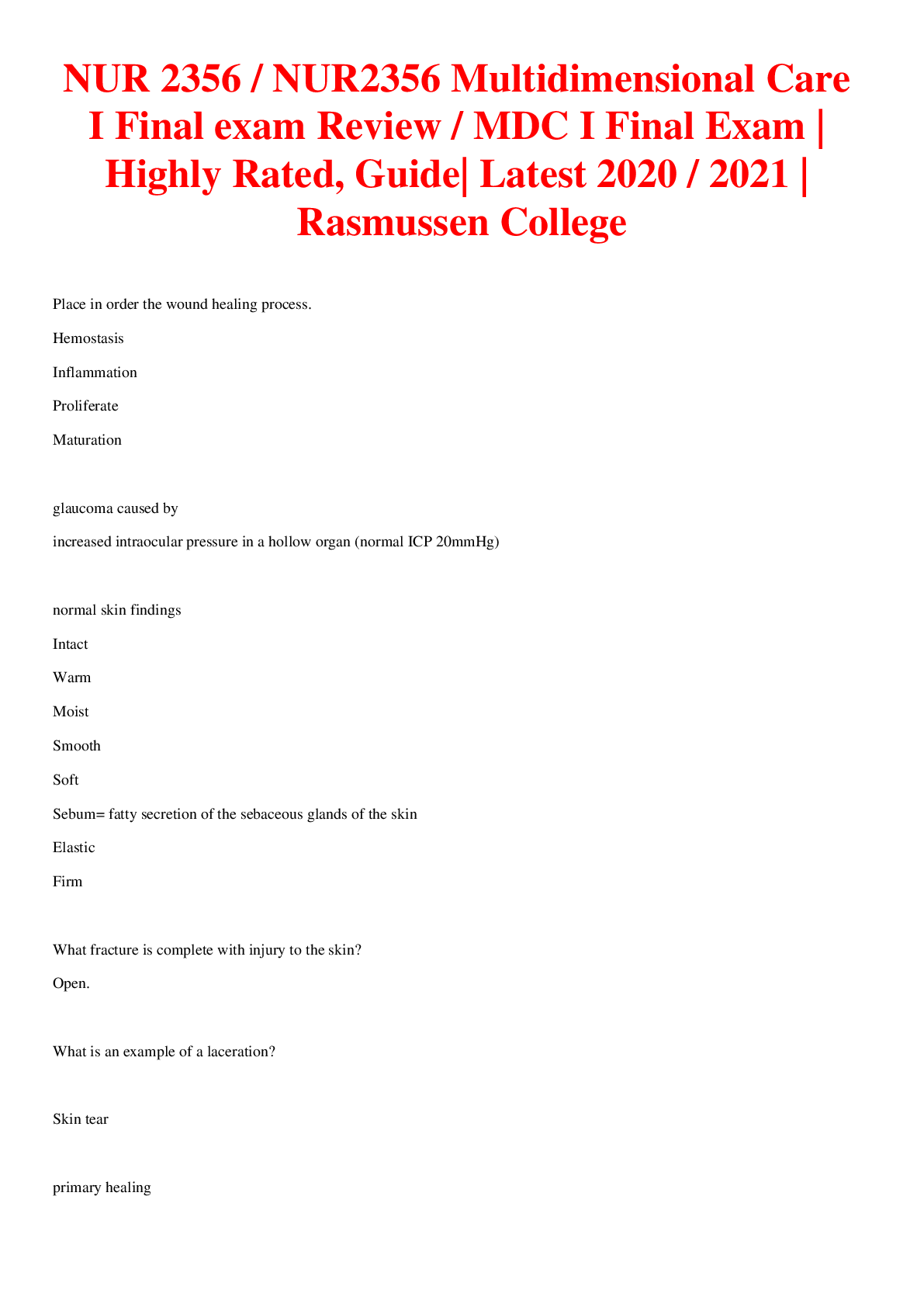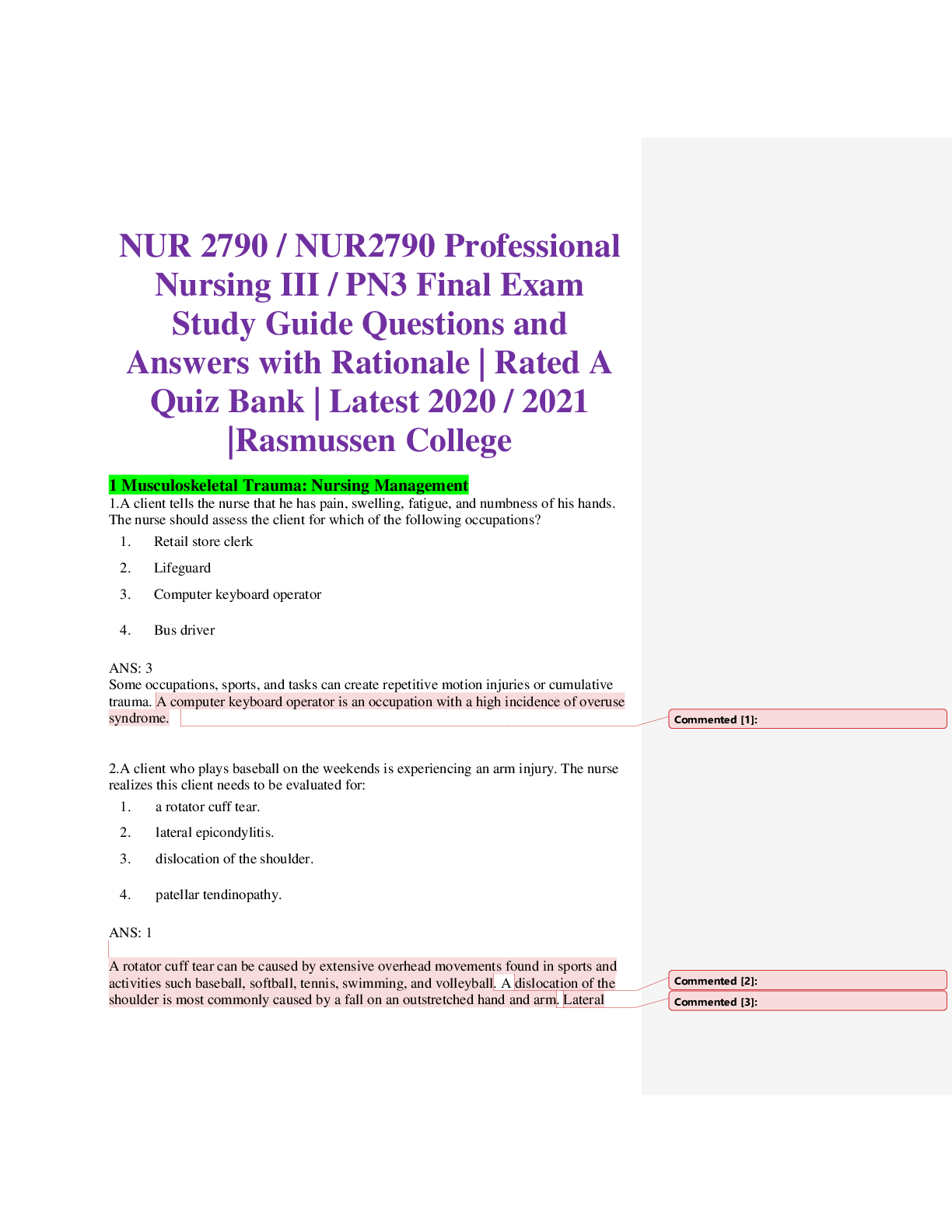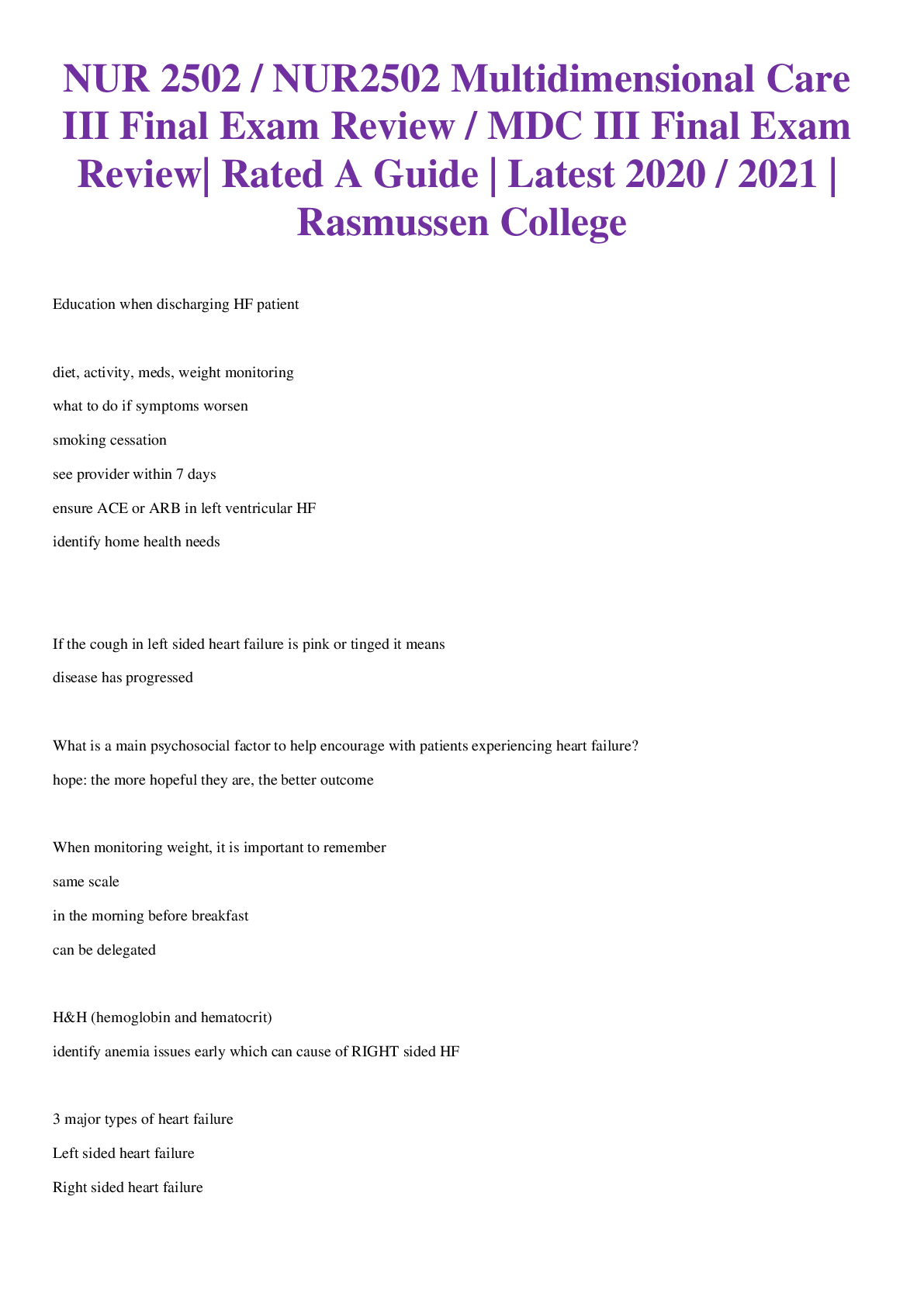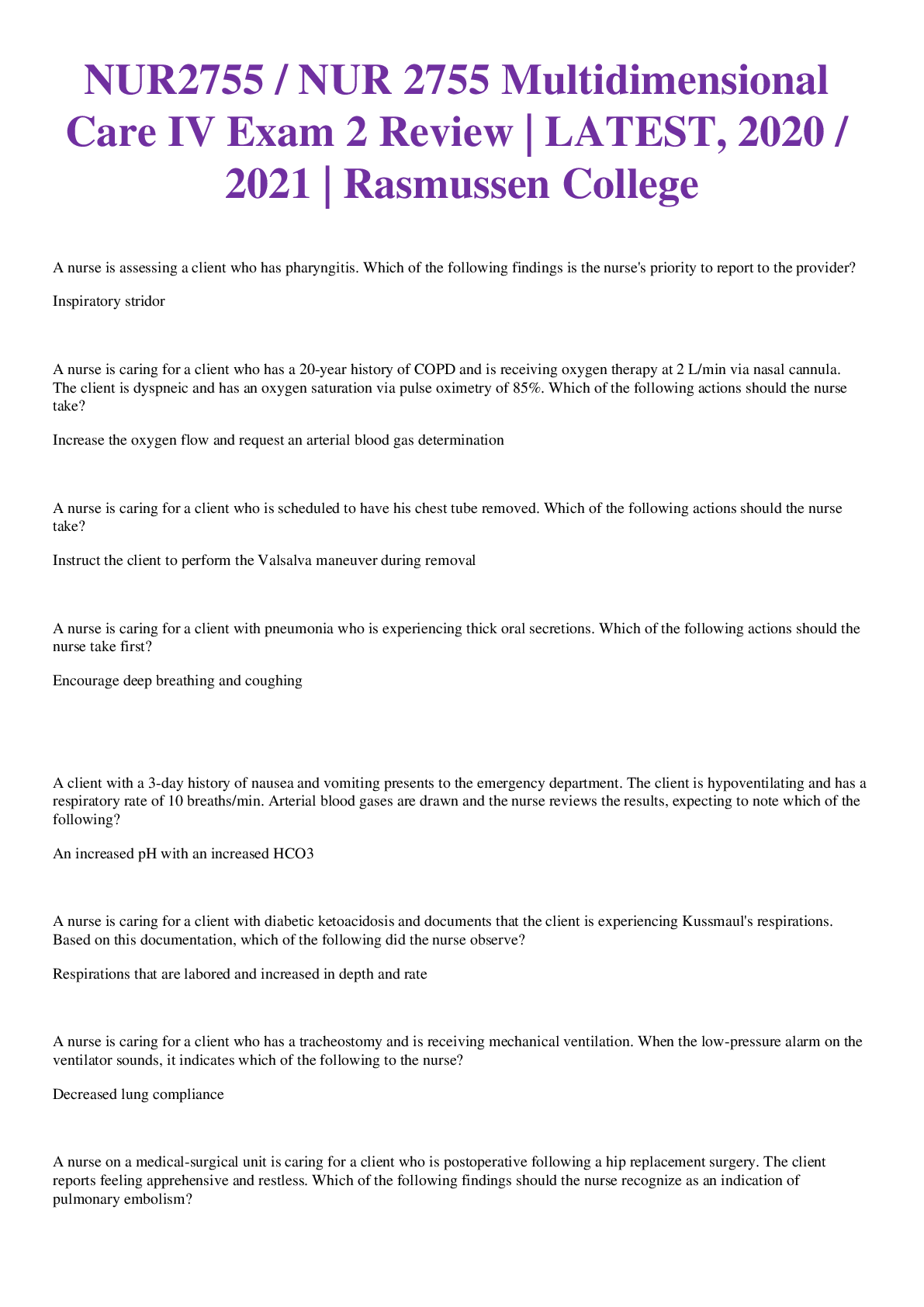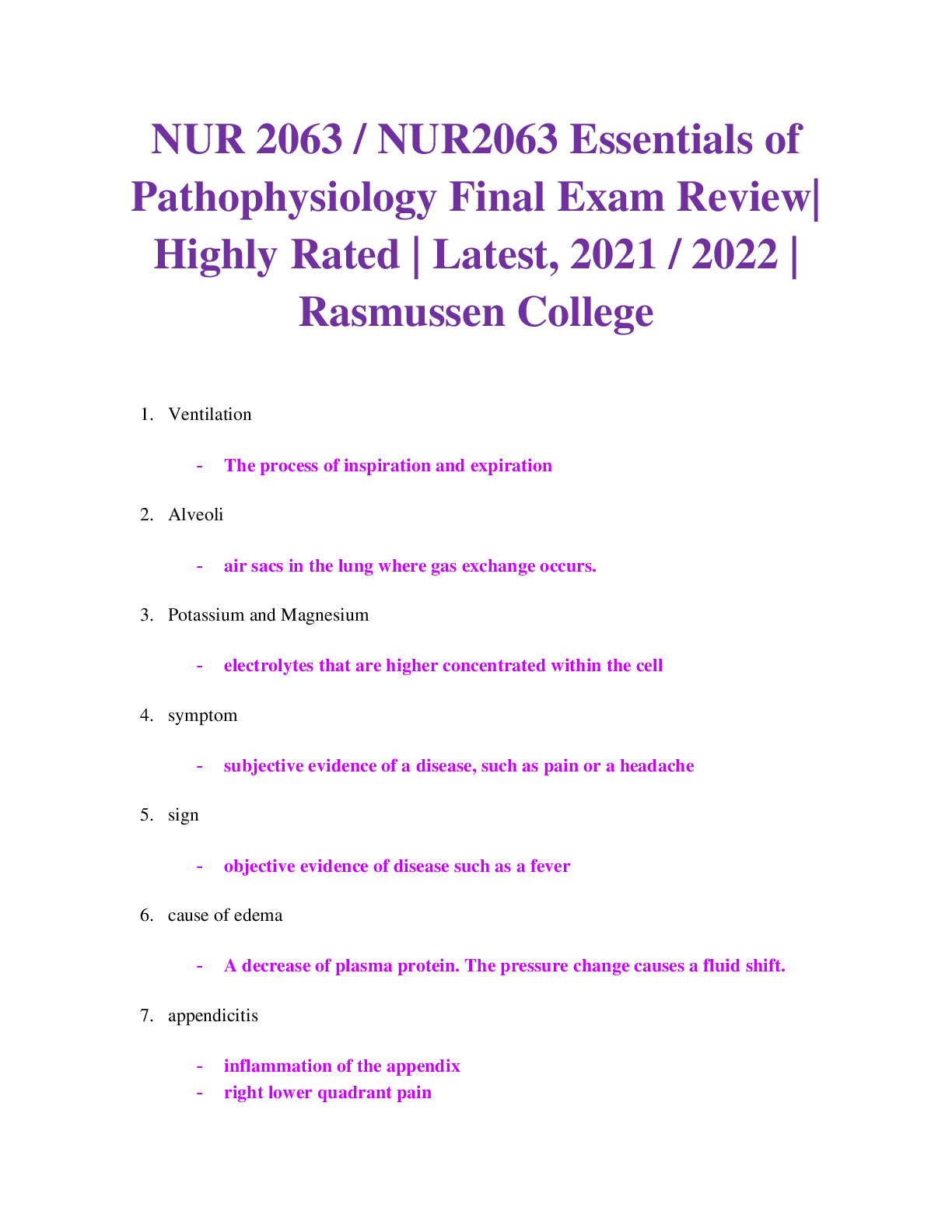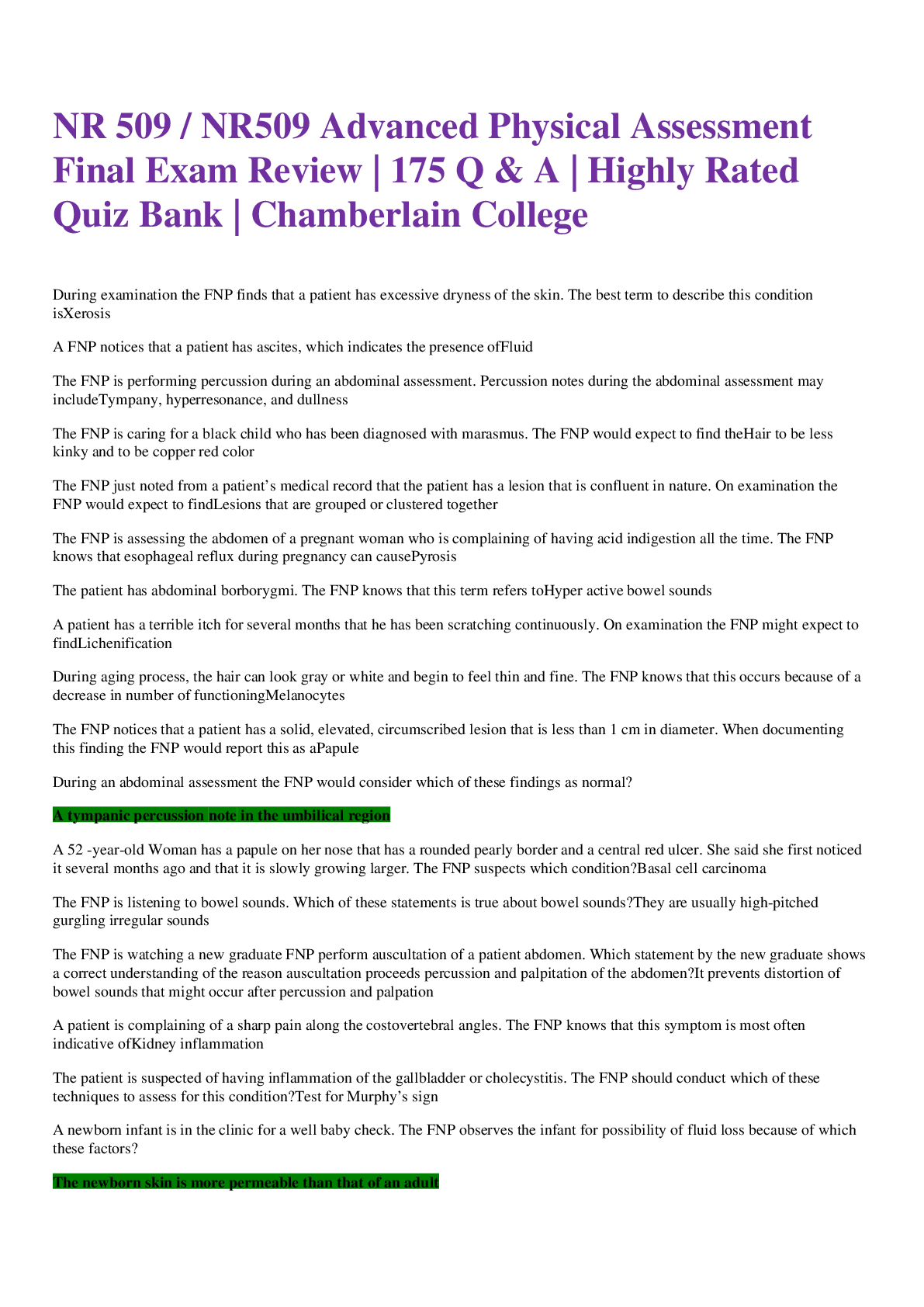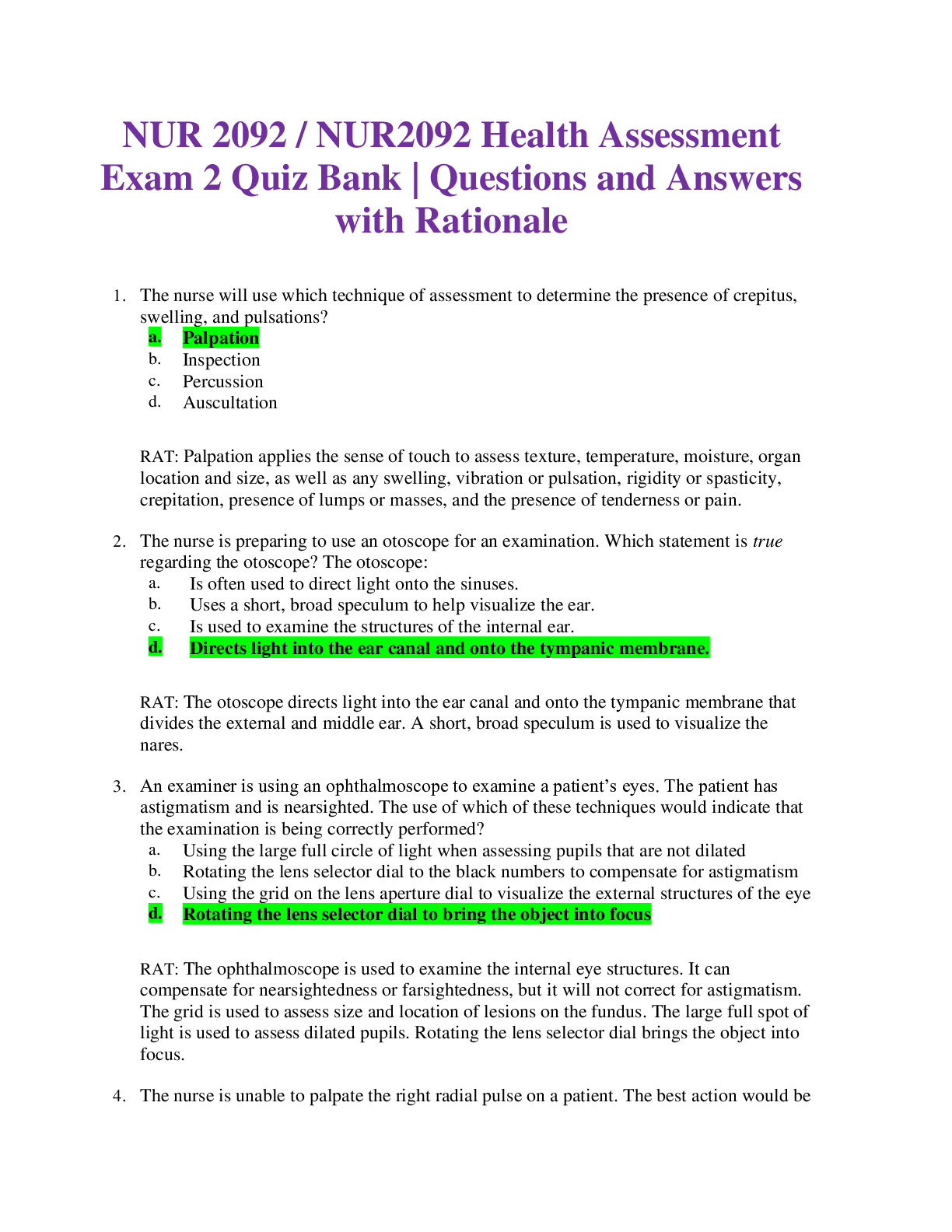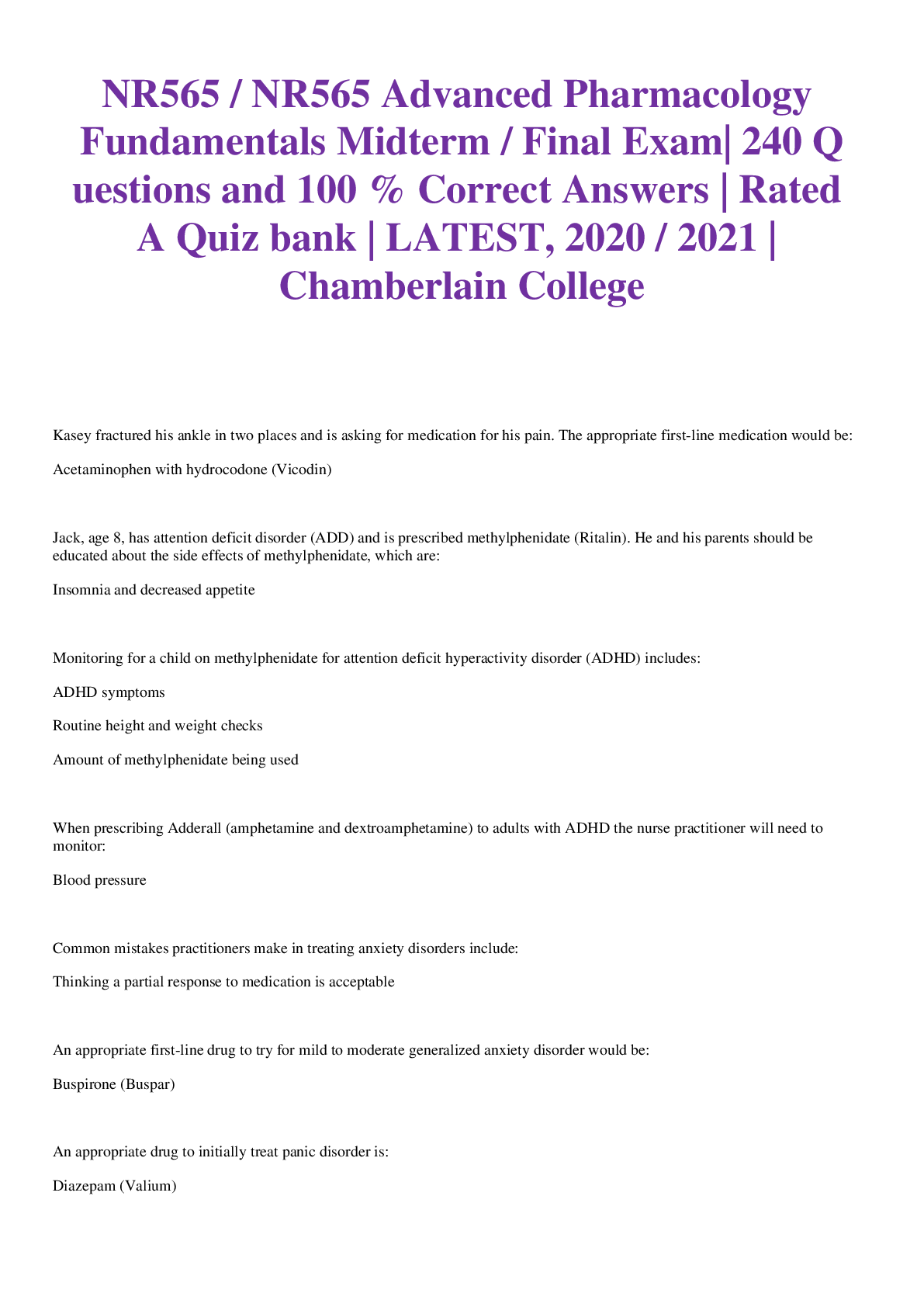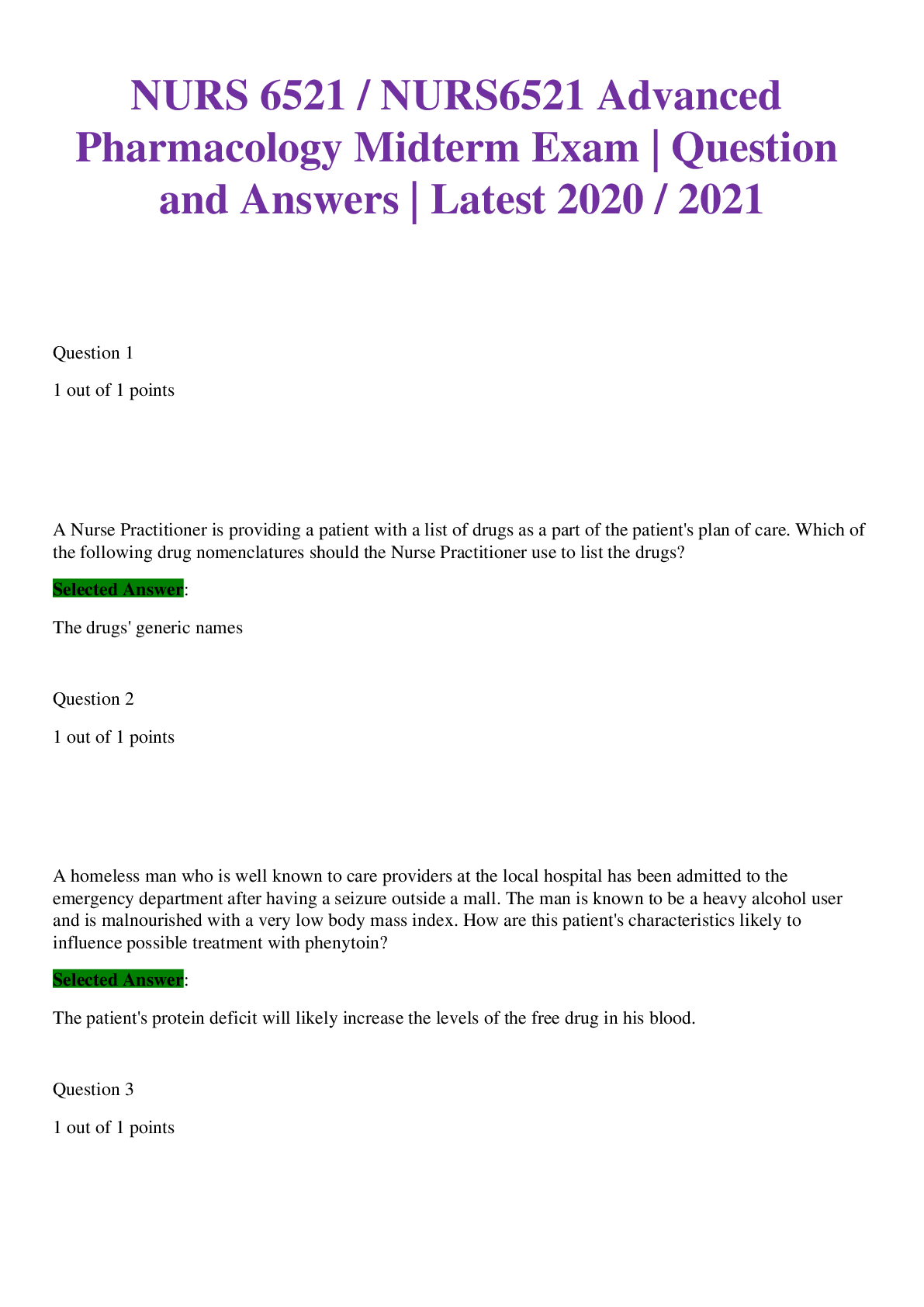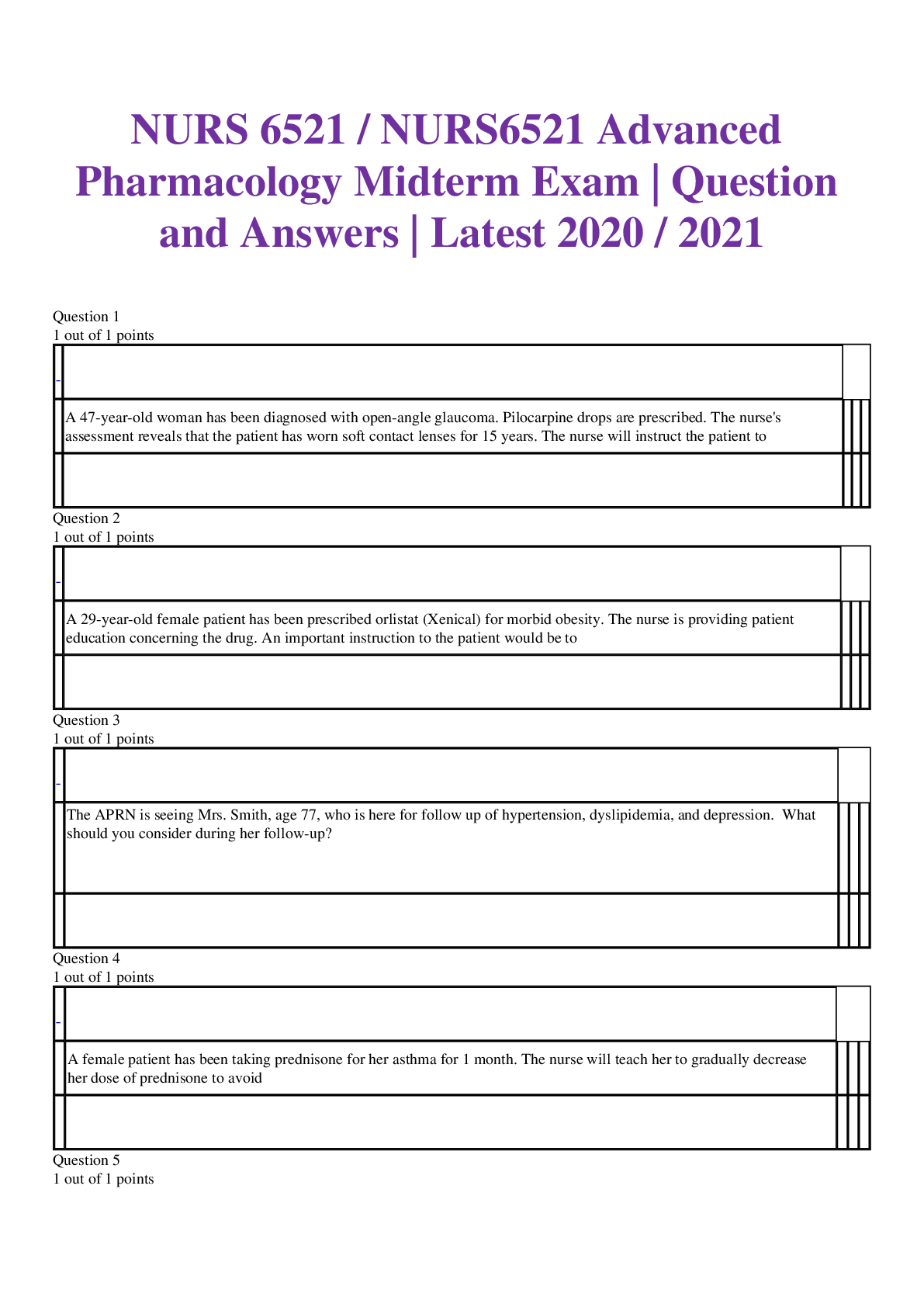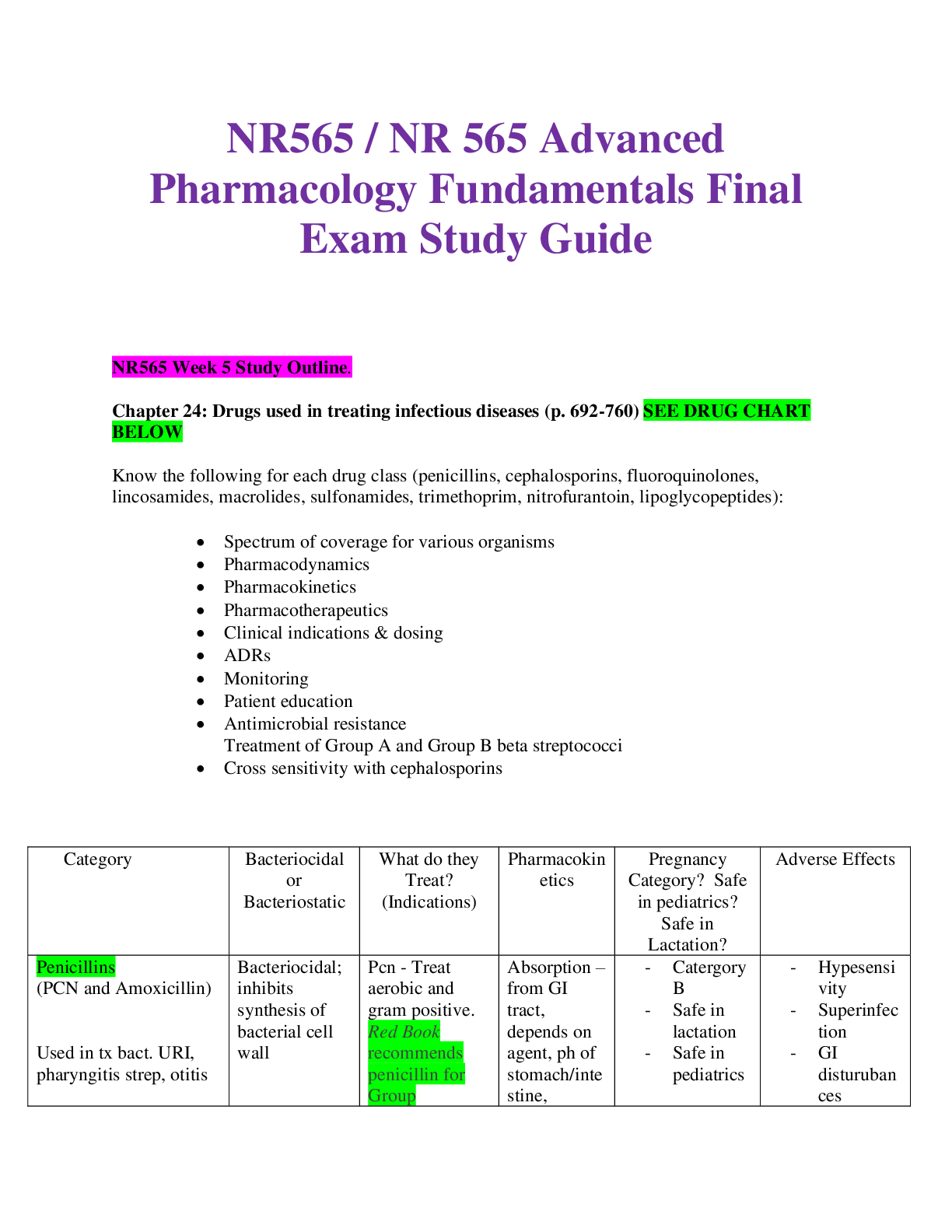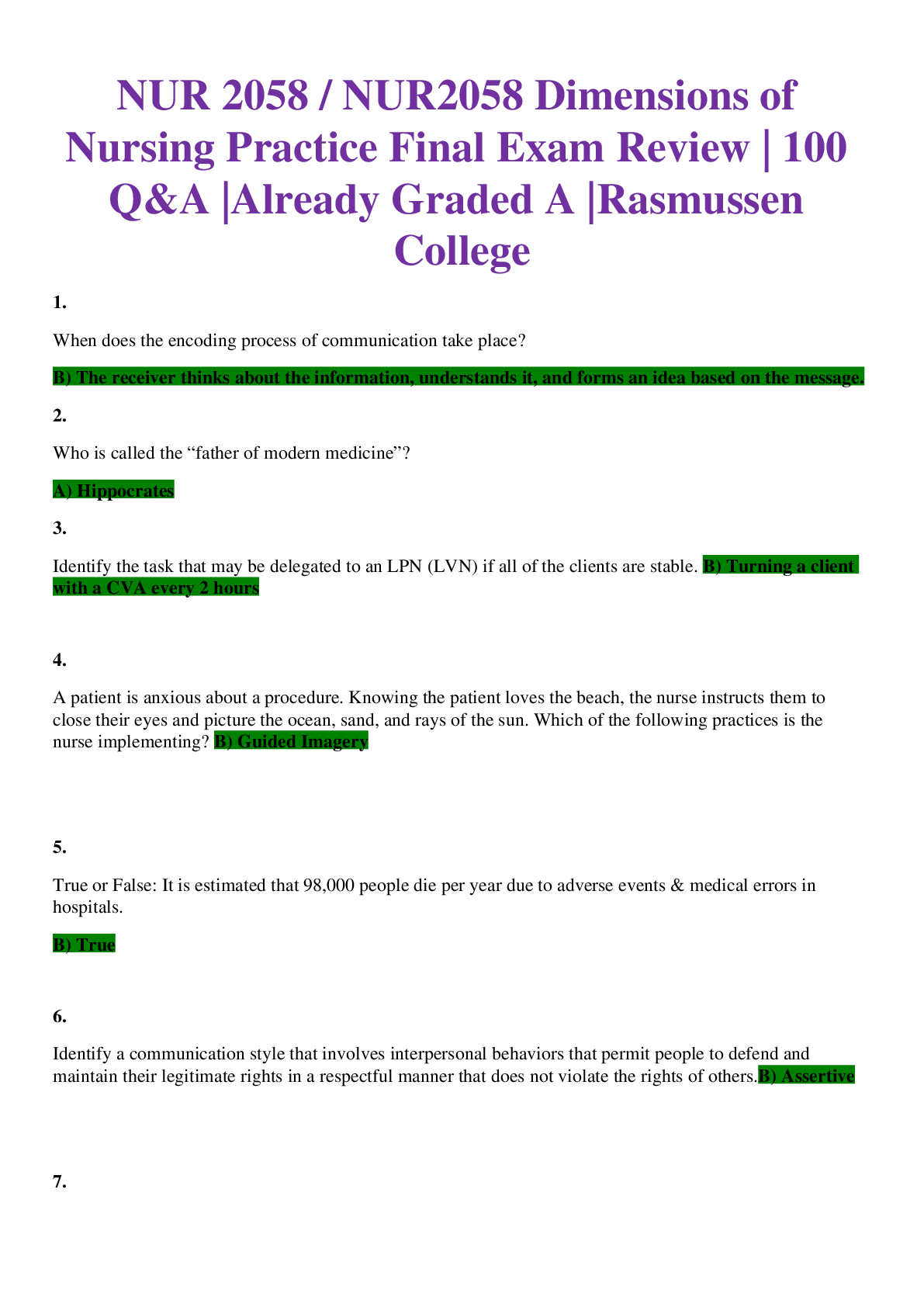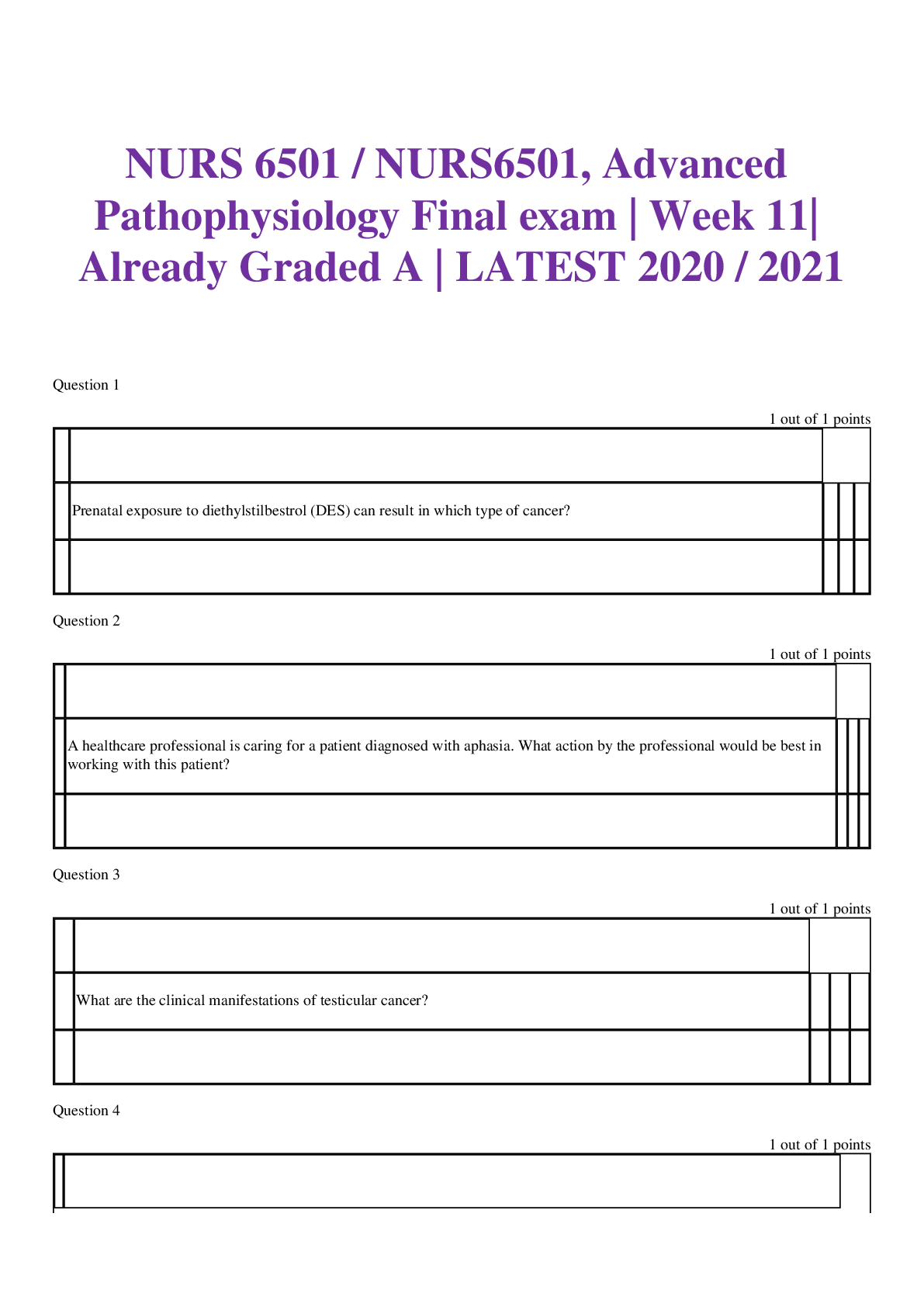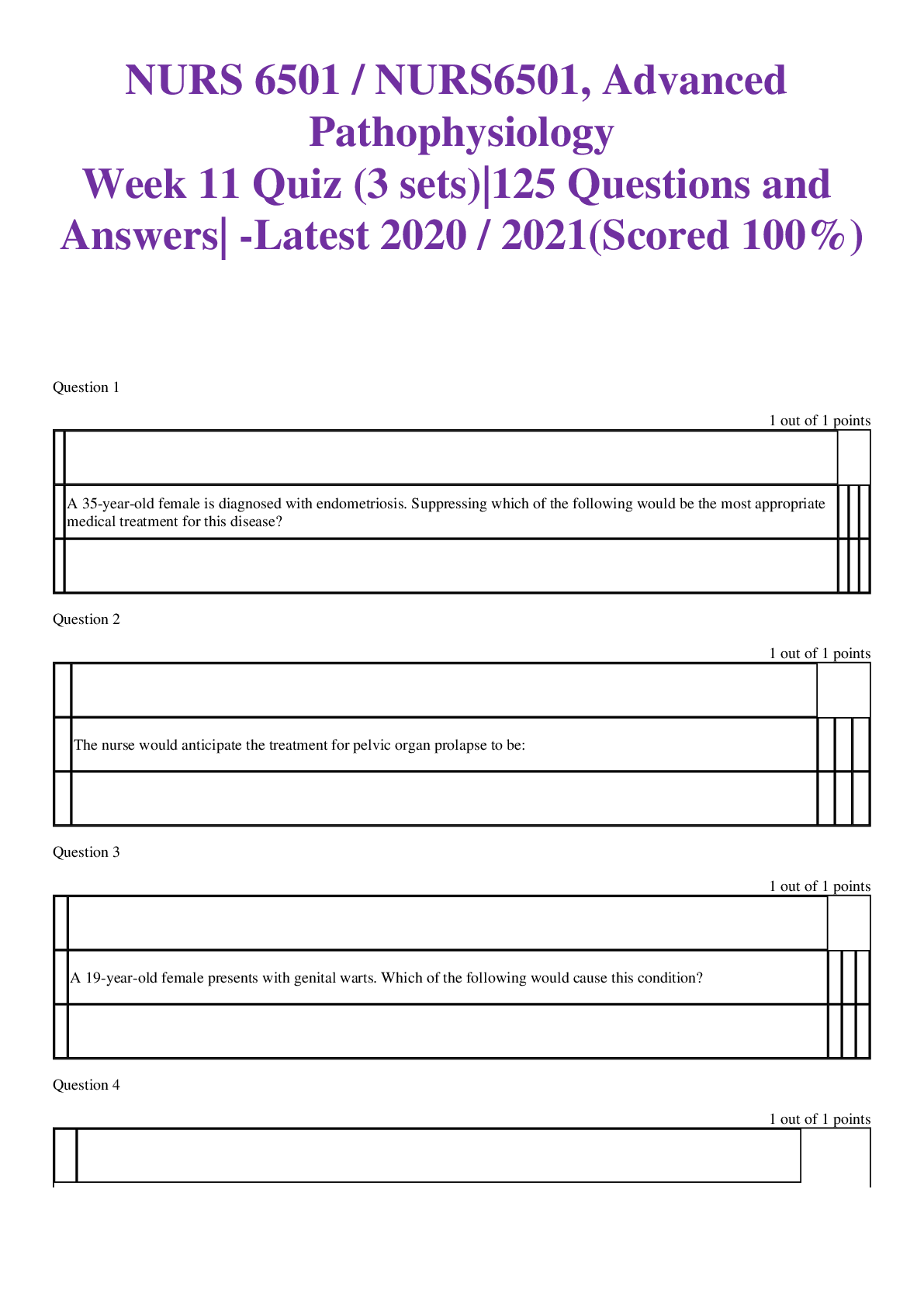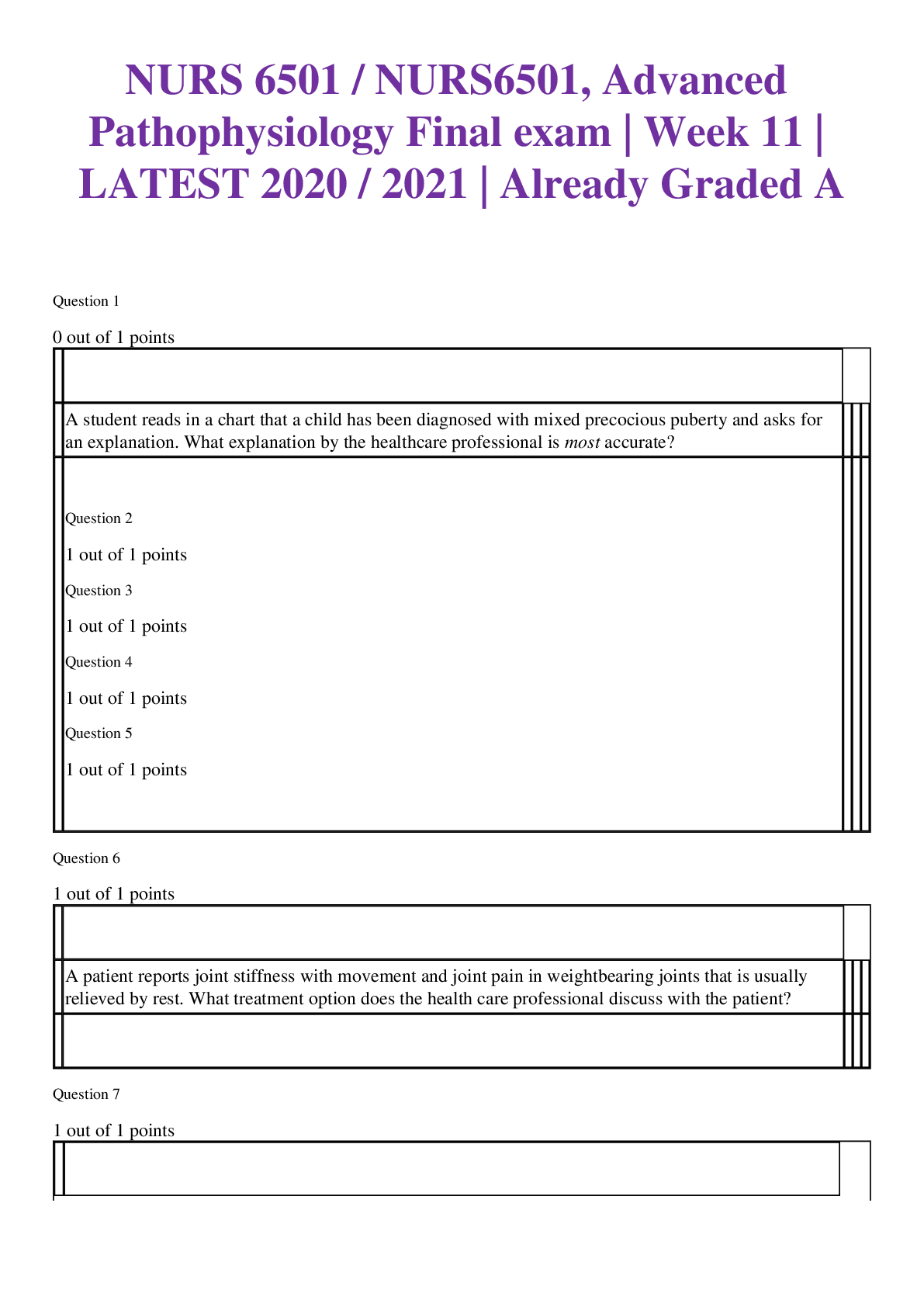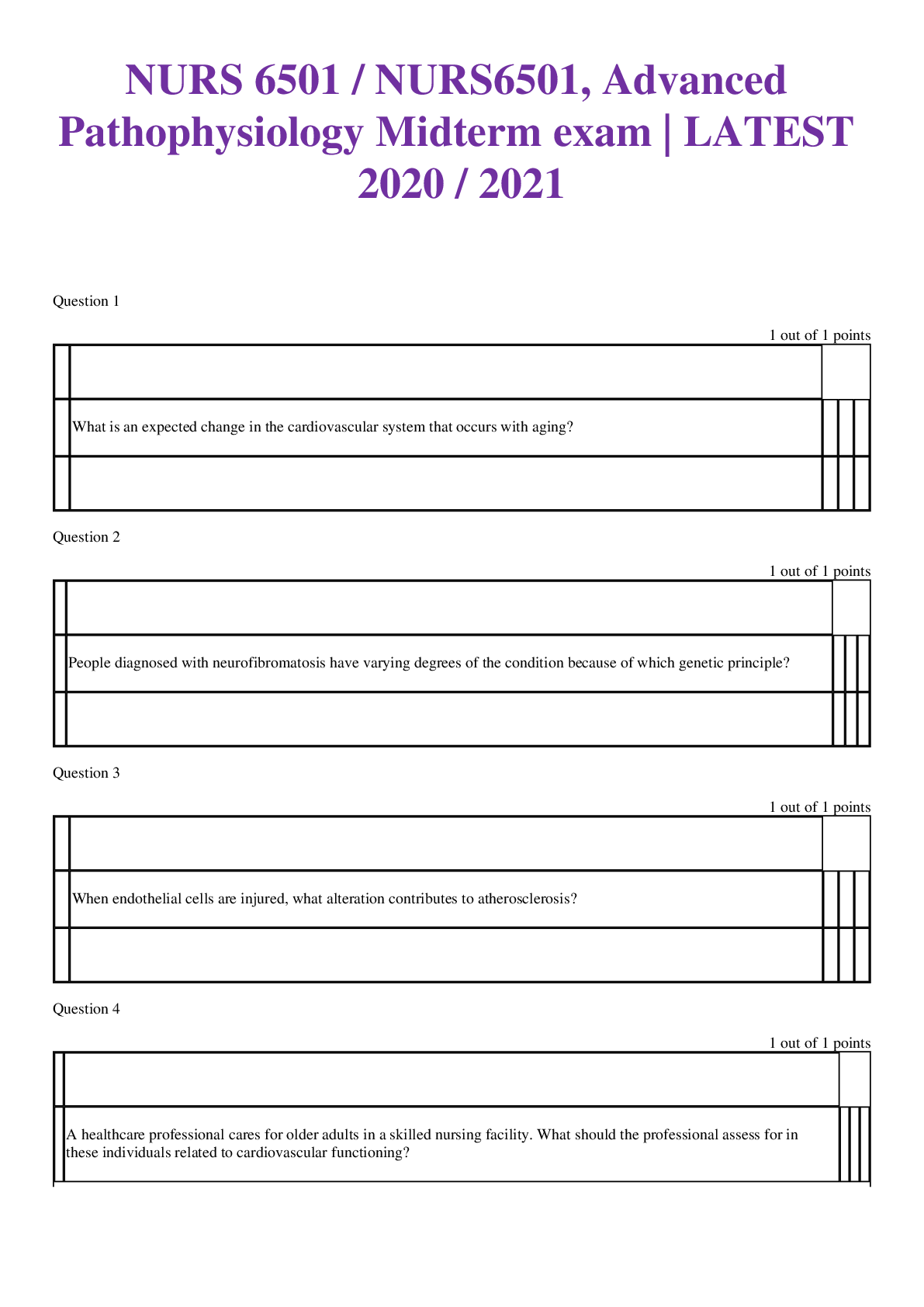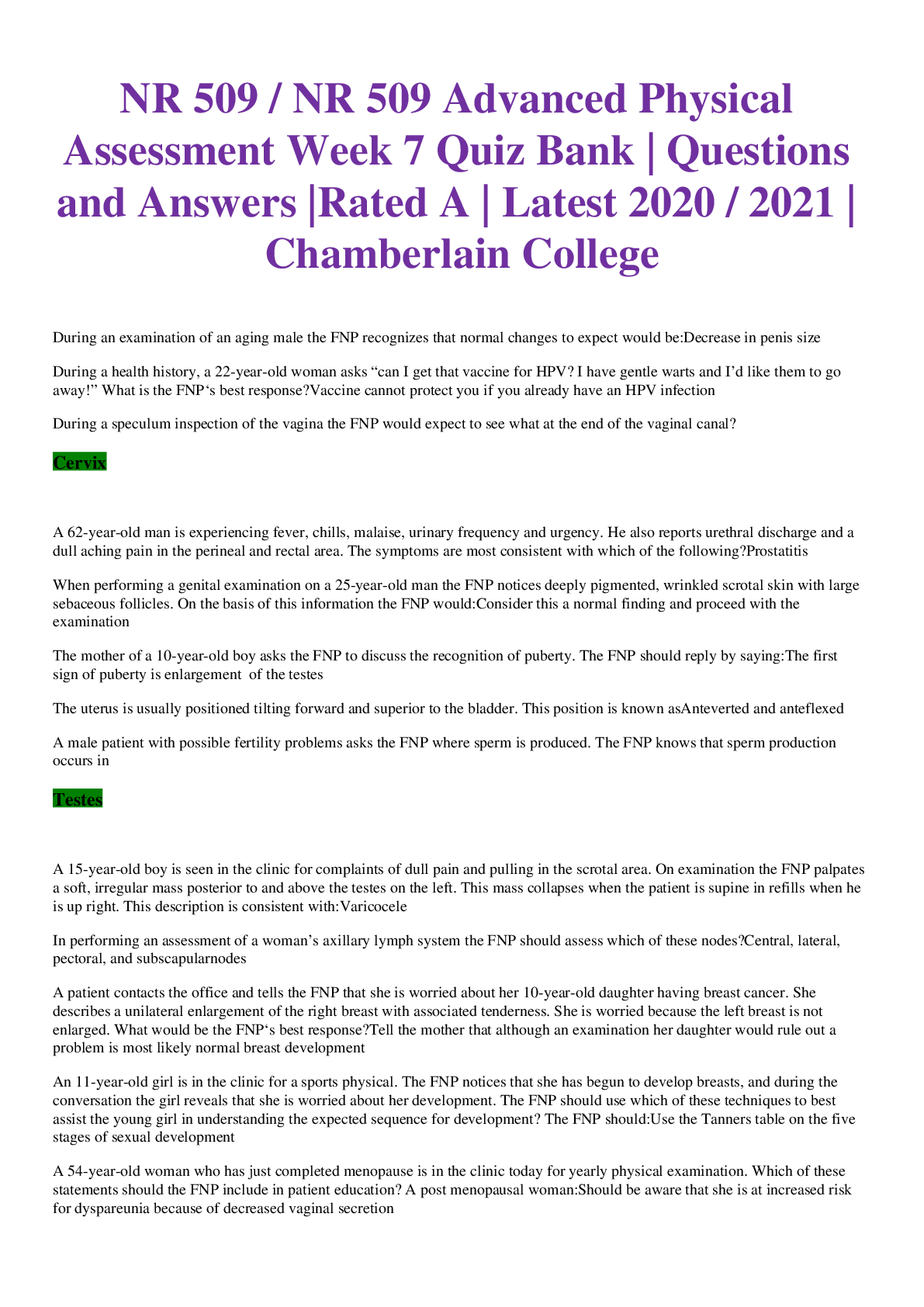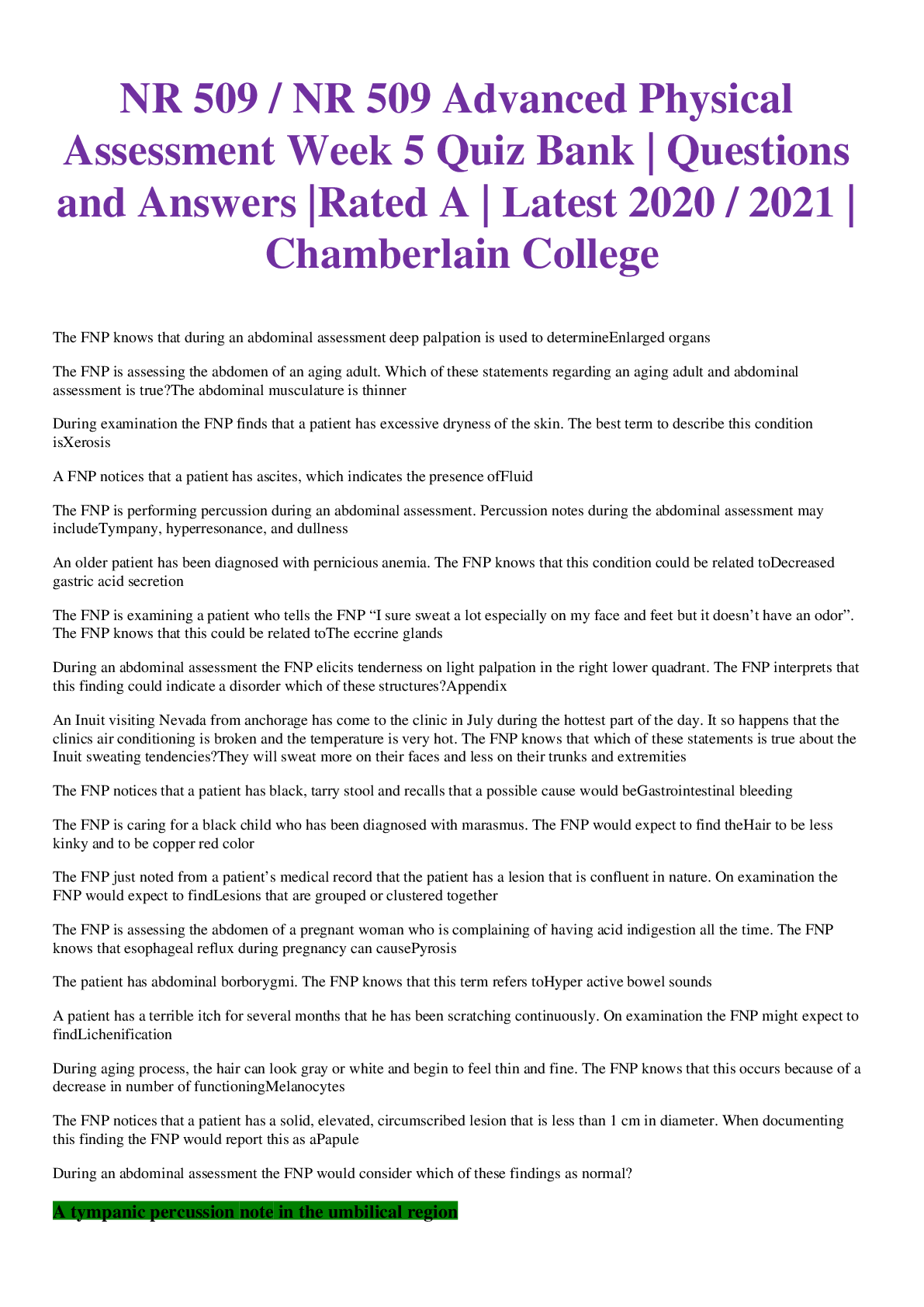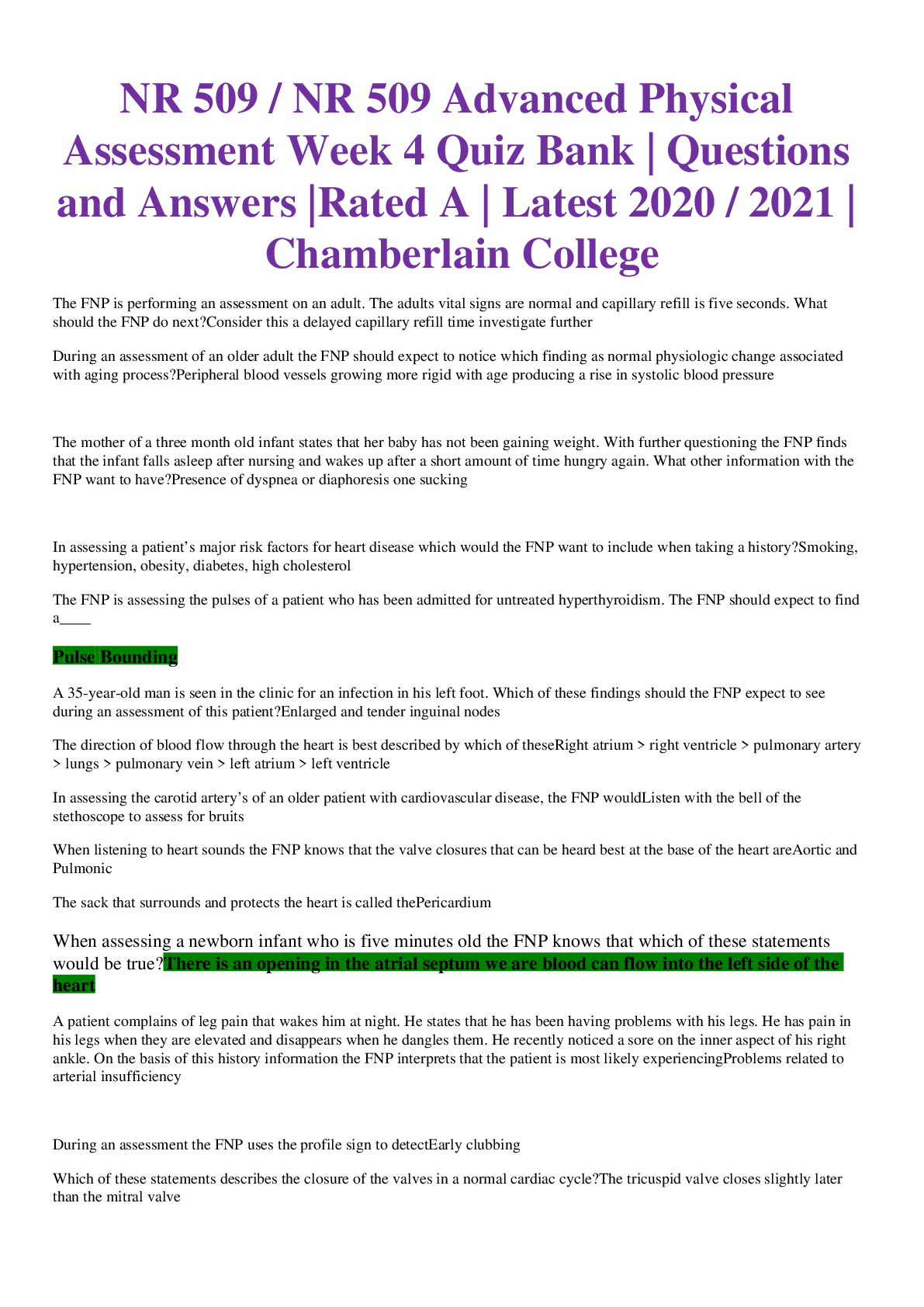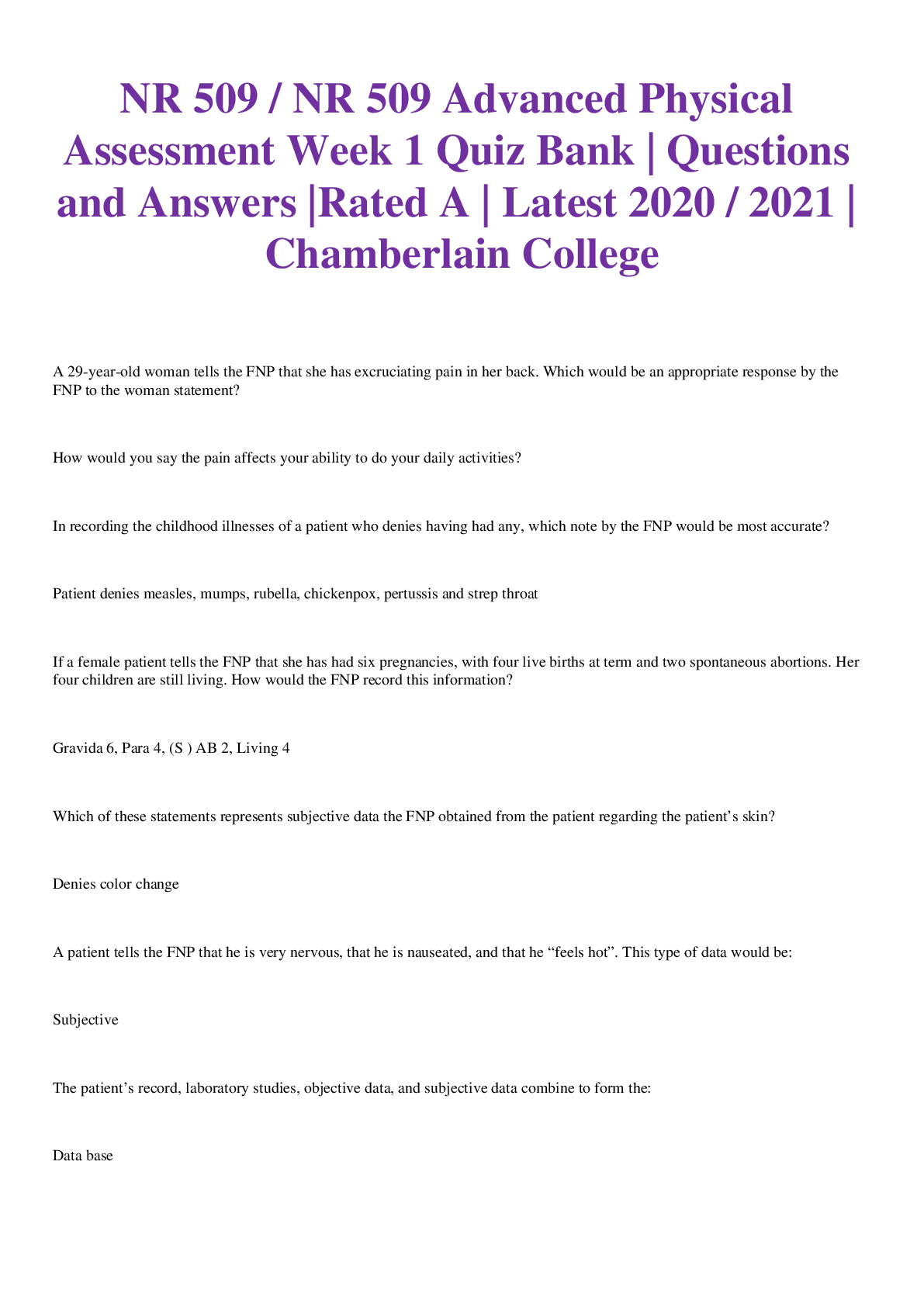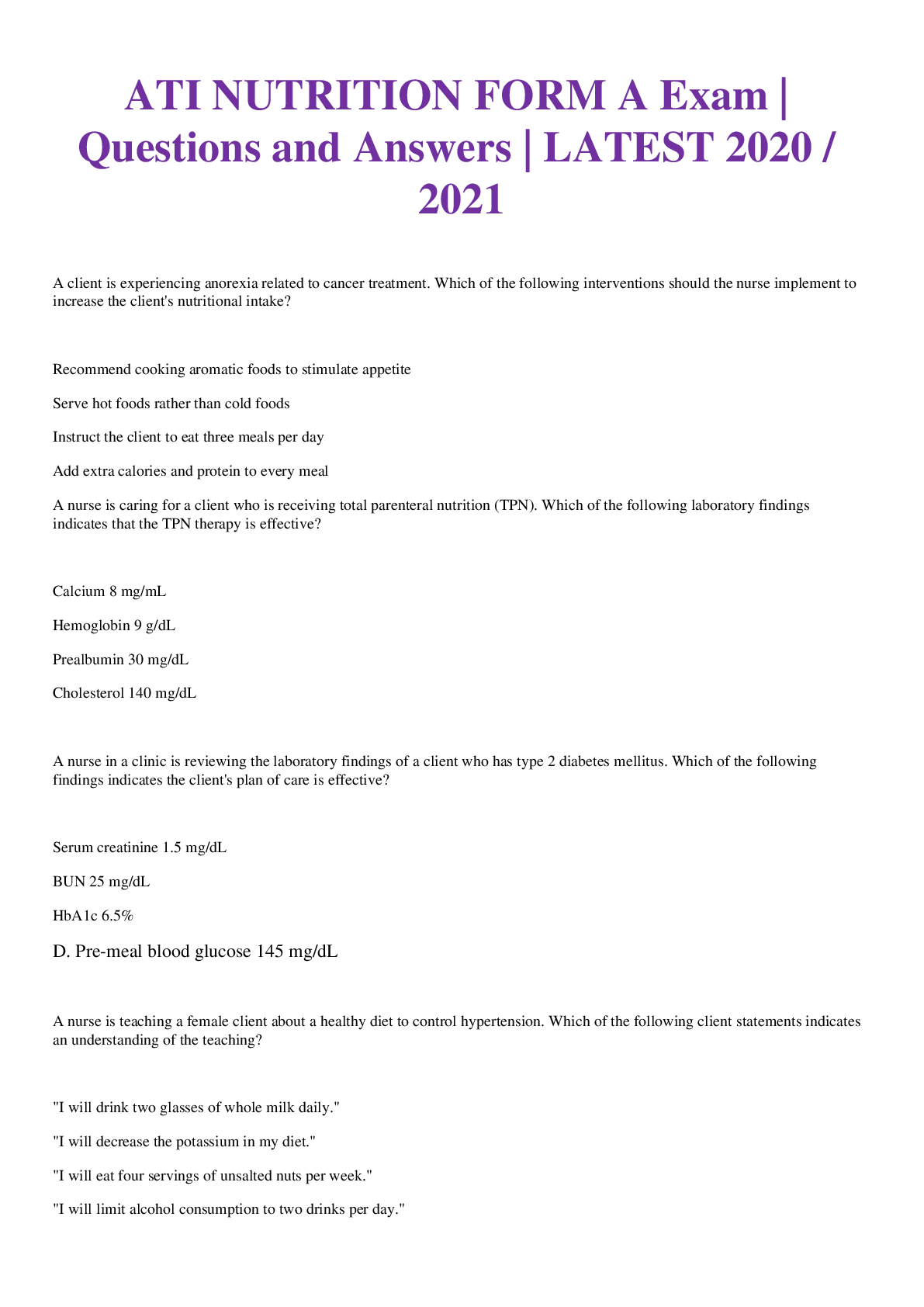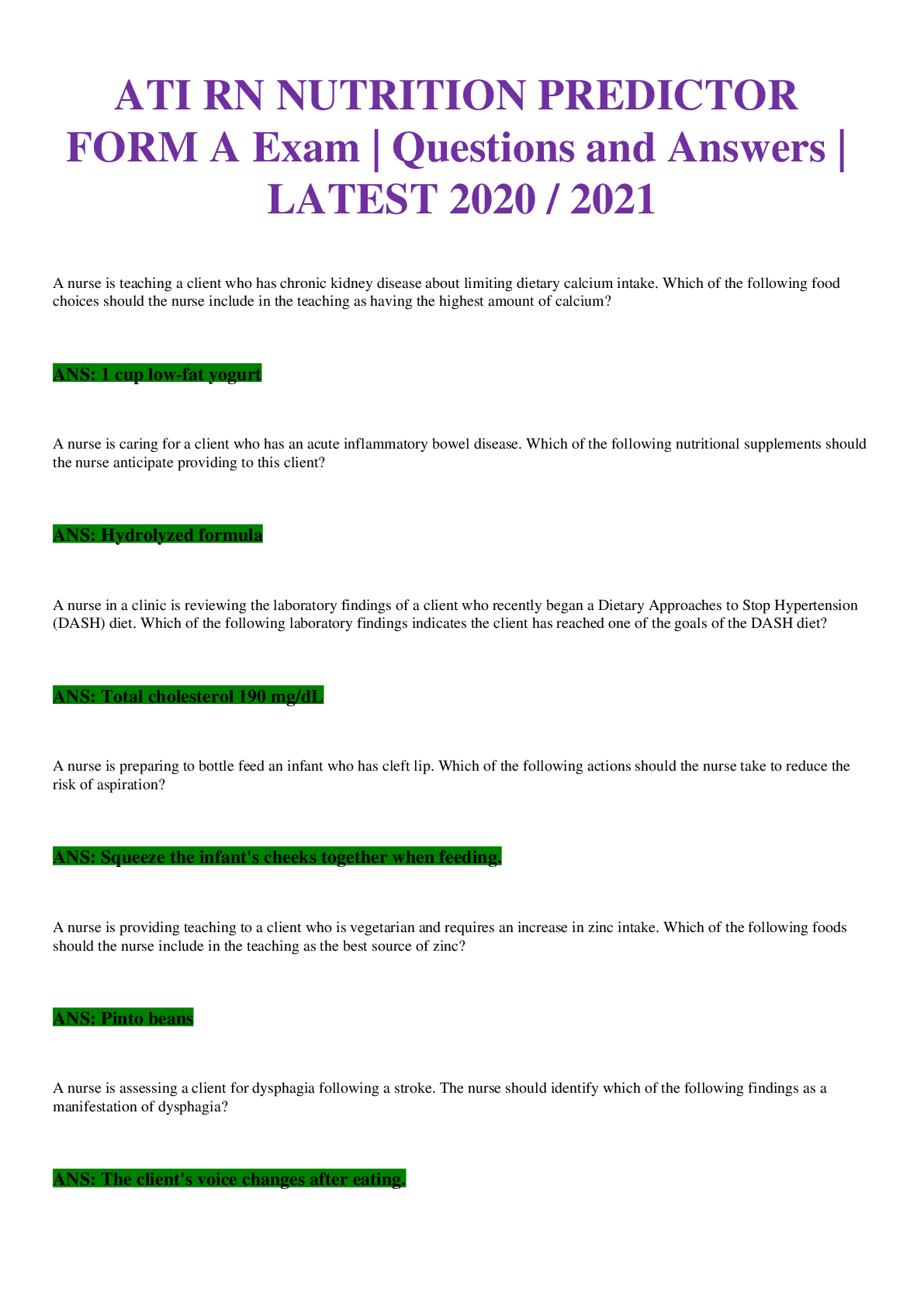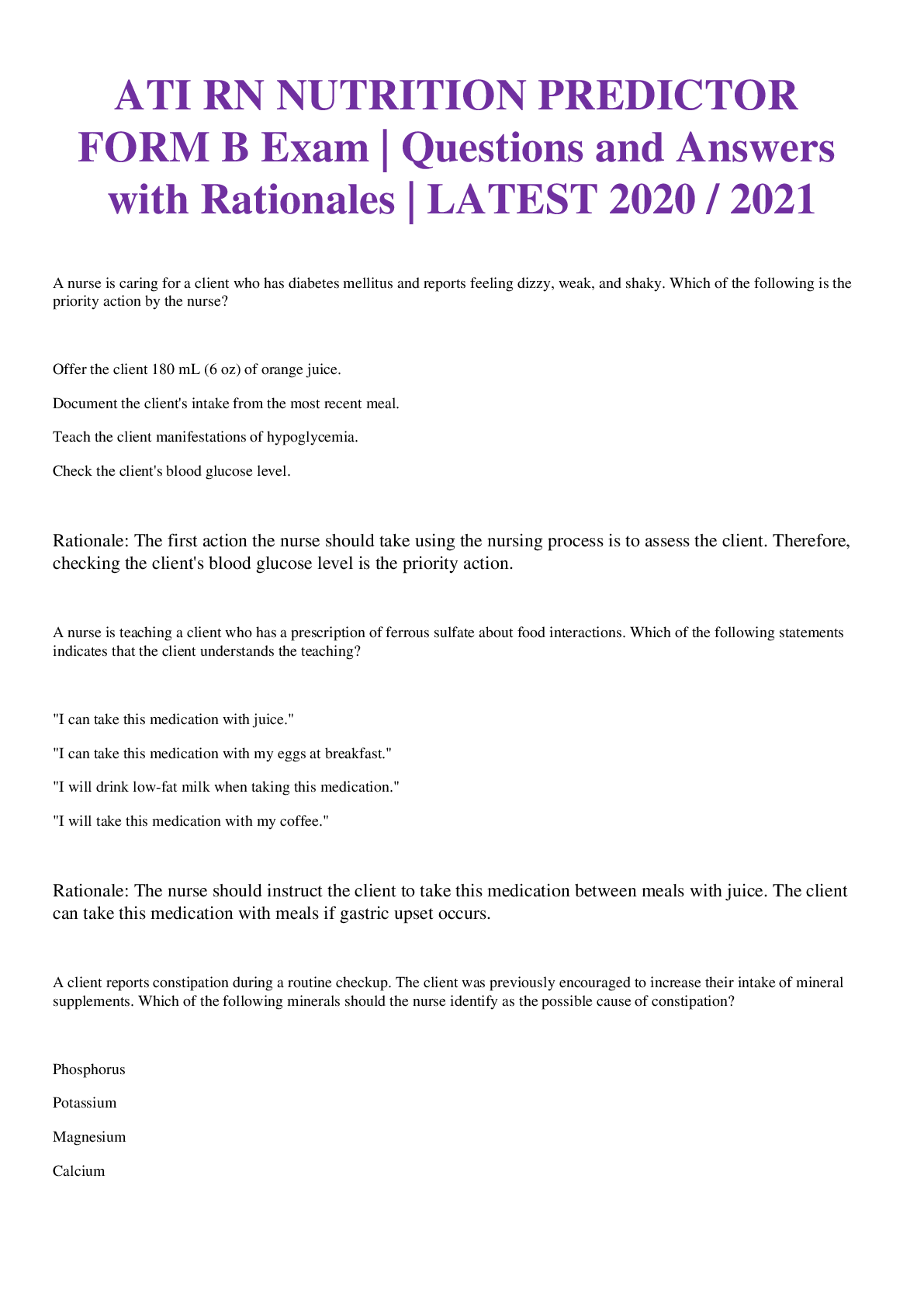*NURSING > EXAM > NR 507 / NR507 Advanced Pathophysiology Study Guide with Practice Questions |Rated A Guide| Latest 2 (All)
NR 507 / NR507 Advanced Pathophysiology Study Guide with Practice Questions |Rated A Guide| Latest 2020 / 2021 | Chamberlain College
Document Content and Description Below
NR 507 / NR507 Advanced Pathophysiology Study Guide with Practice Questions |Rated A Guide| Latest 2020 / 2021 | Chamberlain College 1. Types of anemia reduction of the total number of erythrocytes... in the circulating blood or a decrease in the quality or quantity of hemoglobin. Anemias commonly result from impaired erythrocyte production, blood loss, increases erythrocyte destruction, or a combination of these three factors. a. Pernicious Anemia (PA)- The most common type of megaloblastic anemia, is caused by vitamin B12 deficiency, which is often associated with the end stage of type A chronic atrophic gastritis. b. Macrocytic-normochromic anemia- large abnormally shaped erythrocytes but normal hemoglobin concentrations (Pernicious- lack of B12, abnormal RNA and DNA synthesis and early cell death, folate deficiency- lack of folate for erythropoiesis premature cell death) c. Microcytic-hypochromic anemia- Small abnormally shaped erythrocytes and reduced hemoglobin concentration (Iron deficiency- lack of Fe for hemoglobin production, insufficient hemo, sideroblastic- dysfunctional iron uptake by erythroblasts and defective porphyrin and heme synthesis, thalassemia- impaired synthesis of alpha and beta chain of hemoglobin, phagocytosis of abnormal erythroblasts in the marrow) d. Normocytic-normochromic anemia- normal size, normal hemo concentration (aplastic- insufficient erythropoiesis, posthemorrhagic- blood lost, hemolytic- premature destruction of mature erythrocytes in the circulation, sickle cell- abnormal hemo synthesis, abnormal cell shape with damage, lysis and phagocytosis, anemia of chronic disease- abnormal demand for new erythrocytes ) Questions Continued therapy of pernicious anemia (PA) generally last how long? • The rest of one’s life Which of the following describes how the body compensates for anemia • Increasing rate and depth of breathing What is the primary cause of the symptoms of polycythemia vera? Increased blood viscosity What is the treatment of choice for pernicious anemia (PA)? • Vitamin B12 by injection What is the function of erythrocytes? • Tissue oxygenation The nurse is collecting data on a patient with suspected pernicious anemia. Which of these signs or symptoms would the nurse expect to find for this patient? Glossitis Megaloblastic anemia is a result of insufficient folic acid or vitamin B12, affecting which of the following? Rapidly turning over cells A patient with anemia who is given iron salts could expect to show a therapeutic increase in hematocrit within 6 to 10 months. After reviewing the major types of anemia, students demonstrate understanding of the info when they identify which of the following as an example of a hemolytic anemia? Sickle cell anemia Which of the following would the nurse encourage a pt. to consume to prevent folic acid anemia? broccoli milk liver A pt. is receiving ferrous sulfate as treatment for iron deficiency anemia. After teaching the pt., which statement indicates the need for additional teaching? "i need to take an antacid with the pill to prevent an upset stomach" An 82-year-old client has pernicious anemia and has been receiving treatment for several years. What is she lacking that results in pernicious anemia? Intrinsic factor An 82-year-old client has pernicious anemia and has been receiving treatment for several years. Which symptom may be confused with another condition in older adults? Dementia A nurse is caring for a client admitted with pernicious anemia. Which set of findings should the nurse expect when assessing the client? Pallor, tachycardia, and a sore tongue During the review of morning lab values on a patient complaining of severe fatigue and a red, swollen tongue, the nurse suspects chronic, severe iron deficiency anemia based on which of the following findings? Low ferritin level You are caring for an 87-year-old female who has been admitted to your unit with iron-deficiency anemia. What would you suspect? Blood loss from the gastrointestinal or genitourinary tract A patient is brought to the ER complaining of fatigue, large amounts of bruising on the extremities, and abdominal pain localized in the left upper quadrant. A health history reveals the patient has been treated three times in the past 2 months for a sore throat. Lab tests indicate severe anemia, significant neutropenia, and thrombocytopenia. Based on the symptoms, with what could the patient be diagnosed? Aplastic anemia. The nurse understands which is the most common type of anemia? Iron-deficiency anemia THE NURSE CARES FOR A CLIENT DIAGNOSED WITH POLYCYTHEMIA VERA. THE NURSE EXPECTS TO MAKE WHICH OBSERVATION? DARK, FLUSHED FACE A 57-year-old male presents to his primary care provider for red face, hands, feet, ears, and headache and drowsiness. A blood smear reveals an increased number of erythrocytes, indicating: • Polycythemia vera (PV) The nurse understands that the client with pernicious anemia will have which distinguishing laboratory findings? • intrinsic factor absent Which type of anemia is associated with normochromic and macrocytic red blood cells (RBCs)? Megaloblastic anemia What is the genetic disorder that is associated with excessive red blood cell (RBC) destruction? Sickle cell anemia A patient's anemia is described as having erythrocytes that demonstrate anisocytosis. The nurse would recognize the erythrocytes would be: Able to assume various shapes A newborn is diagnosed with congenital intrinsic factor deficiency. Which of the following types of anemia will the nurse see documented on the chart? Pernicious anemia A 70-year-old male is brought to the emergency department, where he dies shortly thereafter. Autopsy reveals polycythemia vera (PV). His death was most likely the result of: Cerebral thrombosis A 67-year-old male was diagnosed with polycythemia vera (PV) but refused treatment. His condition is at risk for converting to: Acute myeloid leukemia A 20-year-old female undergoes lab testing for anemia. Results show high iron, bilirubin, and transferrin and low hemoglobin and hematocrit. Which of the following is the most likely diagnosis to be documented on the chart? Sideroblastic anemia How should the nurse prepare a patient who is to receive a Schilling test for pernicious anemia? Administer radioactive cobalamin and measure its excretion in the urine. [Show More]
Last updated: 1 month ago
Preview 1 out of 50 pages
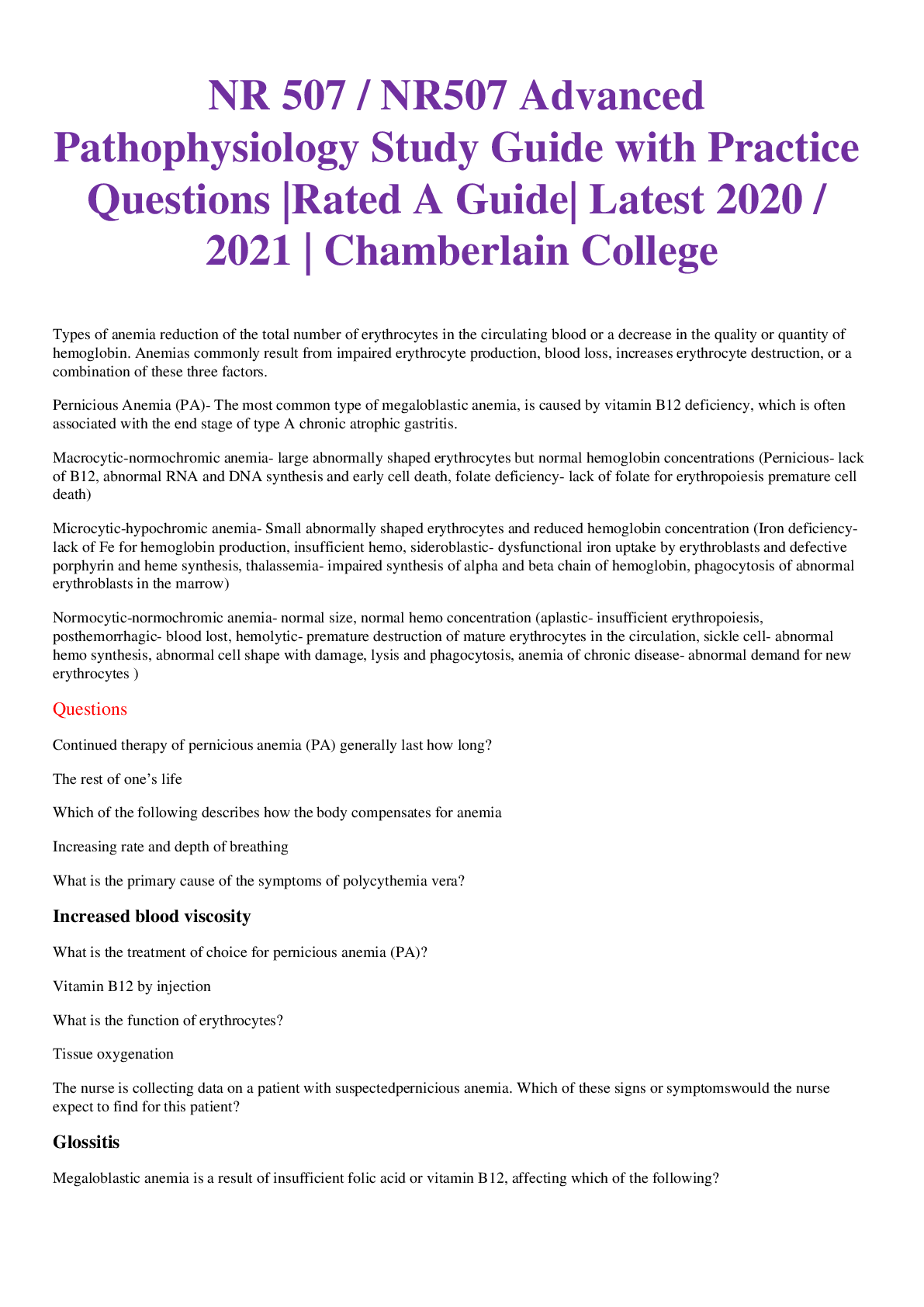
Reviews( 0 )
Document information
Connected school, study & course
About the document
Uploaded On
Dec 20, 2020
Number of pages
50
Written in
Additional information
This document has been written for:
Uploaded
Dec 20, 2020
Downloads
0
Views
53

